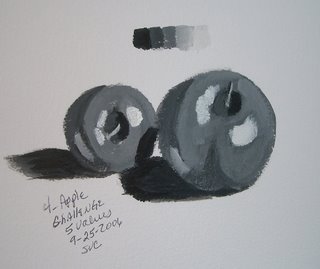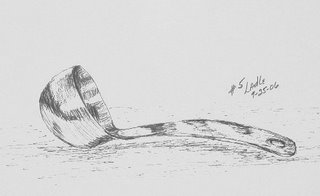
One of the TV artists I have learned from is Helen Van Wyk.(Interesting articles about her on this site>) She worked with the 5 value system. She said you use the body color which is the mid value of an object, the body shadow which is the shadow side of an object, the reflection which is light but not as light as the highlight, the highlight is the lightest and the cast shadow is the darkest. The cast shadow is the shadow cast by the object. It works pretty well, you can see it a little in my apple, hopefully. On a face for example, the nose has a body shadow on the side away from the light, but the little shadow under the nose is a cast shadow. In a portrait you get a reflection under the chin and a cast shadow from the chin. This change in values gives shape and roundness to objects in a still life. You can get a three dimensional look on a flat canvas or paper, called trompe l'oeil.
Another interesting thing in still lifes is that it is darker on the side where the light is coming from and it is darker behind the objects usually and the light is up front with more detail. This is the opposite of landscapes. You make the far away hills paler and bluer to account for the atmosphere and as things get closer, they get darker and more defined.
Just full of information tonight. Next is my number 4 in the hunt. A ladle. Not too hard, except the only ladle in this rent house is a silver (well stainless steel) one to use for serving at the table. Very hard to show shine in pen. Watercolor might have been easier. Will have to try that! At least I should get credit in the challenges for the ellipse.



2 comments:
I think the shine on the ladle shows up very nicely. And, of course, I'm amazed that you can do that thing with the apples and 5 shades of gray. Cool.
On the apples in gray, we were not to blend. If you blend the edges you get beautiful apples!
Thanks for your support! :-)
Post a Comment